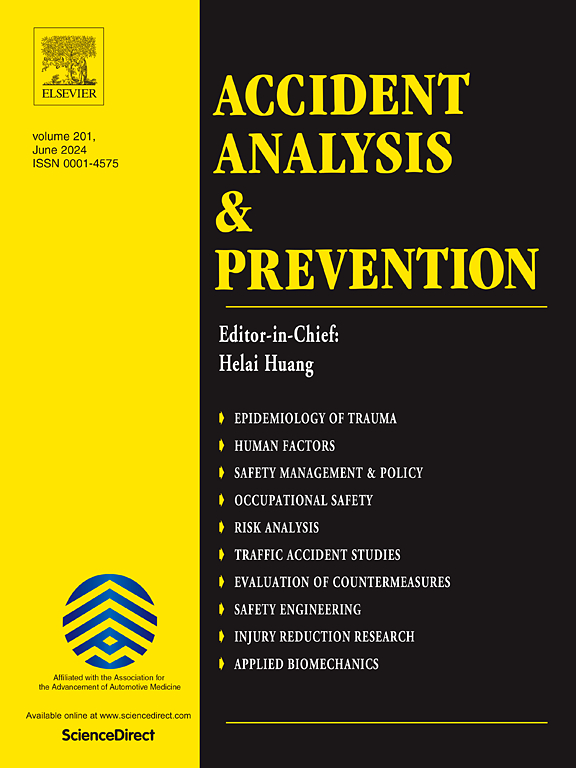Balancing safety and efficiency for autonomous vehicles at urban uncontrolled crosswalk: challenges and countermeasures
IF 6.2
1区 工程技术
Q1 ERGONOMICS
引用次数: 0
Abstract
At uncontrolled crosswalks, defensive autonomous vehicles (DAVs) prioritize yielding to pedestrians but may exacerbate congestion. Interactive autonomous vehicles (IAVs) attempt to prioritize pedestrian passage under safe conditions; however, they demand more advanced technology, and their practical application remains uncertain. Platoon control presents a potential solution to mitigate the limitations of both driving styles. This study develops an agent-based pedestrian-vehicle interaction framework and introduces a platoon formation module that accounts for passenger comfort. The study examines the impact of combining driving styles (DAV and IAV) and the platoon control method on the safety and efficiency of pedestrian-AV interactions. Results indicate that compared to DAV, IAV increases interaction events by 32.2%, yet achieves a yielding compliance rate of only 40% while reducing total delays by 60.7%. Platoon control effectively enhances the safety and efficiency of both driving styles, with its benefits becoming more pronounced as pedestrian and vehicle traffic volumes increase. This study provides methodologies and strategies to address the challenges of integrating AVs into urban environments.
城市非受控人行横道自动驾驶车辆安全与效率的平衡:挑战与对策
在不受控制的人行横道上,防御性自动驾驶汽车(DAVs)优先考虑让路给行人,但可能会加剧拥堵。交互式自动驾驶汽车(IAVs)试图在安全条件下优先考虑行人通道;然而,它们需要更先进的技术,而且它们的实际应用仍然不确定。组队控制提供了一个潜在的解决方案,以减轻这两种驾驶风格的局限性。本研究开发了一个基于智能体的行人-车辆交互框架,并引入了考虑乘客舒适度的排队形模块。本研究考察了混合驾驶风格(DAV和IAV)和排控方式对行人-自动驾驶互动的安全性和效率的影响。结果表明,与DAV相比,IAV使交互事件增加了32.2%,但顺从率仅为40%,总延迟减少了60.7%。排控有效地提高了两种驾驶方式的安全性和效率,随着行人和车辆交通量的增加,其好处变得更加明显。本研究为解决将自动驾驶汽车融入城市环境的挑战提供了方法和策略。
本文章由计算机程序翻译,如有差异,请以英文原文为准。
求助全文
约1分钟内获得全文
求助全文
来源期刊

Accident; analysis and prevention
Multiple-
CiteScore
11.90
自引率
16.90%
发文量
264
审稿时长
48 days
期刊介绍:
Accident Analysis & Prevention provides wide coverage of the general areas relating to accidental injury and damage, including the pre-injury and immediate post-injury phases. Published papers deal with medical, legal, economic, educational, behavioral, theoretical or empirical aspects of transportation accidents, as well as with accidents at other sites. Selected topics within the scope of the Journal may include: studies of human, environmental and vehicular factors influencing the occurrence, type and severity of accidents and injury; the design, implementation and evaluation of countermeasures; biomechanics of impact and human tolerance limits to injury; modelling and statistical analysis of accident data; policy, planning and decision-making in safety.
 求助内容:
求助内容: 应助结果提醒方式:
应助结果提醒方式:


